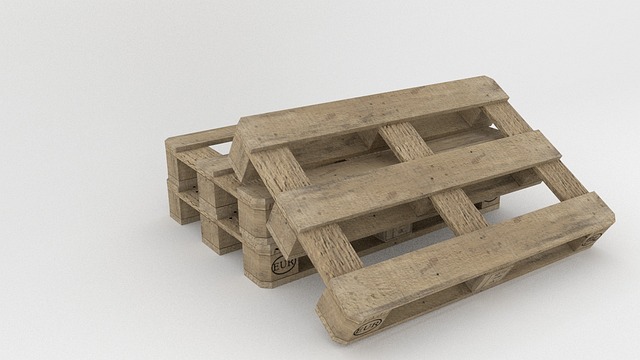If you’ve ever wandered through your local hardware store or stumbled upon a stack of pallets, you might have wondered if these seemingly versatile wooden structures can also serve as a source of cozy warmth during chilly evenings. “Do pallets make good firewood?”
Yes, pallets can be used as firewood, but caution is essential. Opt for untreated pallets without chemicals, paints, or stains. Remove nails and inspect for safety. Proper processing, seasoning, and ventilation are key. Mix with traditional firewood for efficient and safe burning. Always prioritize safety and choose responsibly sourced pallets.
But before you start hauling pallets into your woodshed, let’s take a closer look at the pros and cons, the do’s and don’ts, and everything in between. Let’s get started!
The Appeal of Pallets as Firewood
Let’s kick things off by delving into why the idea of using pallets as firewood has sparked (pun intended) so much interest among DIY enthusiasts and eco-conscious folks alike. Pallets, those wooden platforms that transport goods and dreams, have a certain allure that’s hard to ignore.
Cost-Effectiveness and Availability One of the most appealing aspects of using pallets as firewood is their affordability and accessibility. Pallets are often discarded or sold at a fraction of the cost of traditional firewood. If you’ve ever crunched the numbers on your heating bill, you know that finding an economical source of warmth is like hitting the jackpot. Pallets can be a budget-friendly option for keeping the cold at bay.
Embracing the Environmental Angle Now, let’s talk about the green factor. We’re living in an era where sustainability is more than just a buzzword – it’s a way of life. Repurposing pallets for firewood aligns perfectly with this eco-conscious mindset. By giving these pallets a second life, you’re reducing the demand for new wood and, in turn, lessening the strain on our forests. It’s a small step toward making a positive impact on the planet.
So, whether you’re a DIY champion on the hunt for your next crafting project or someone who’s looking to heat their home in an environmentally friendly way, pallets offer an intriguing solution. But, as with any adventure, there’s more to the story than meets the eye.
In the next sections, I’ll uncover the nitty-gritty details of using pallets as firewood – the good, the cautionary, and the downright practical. Stick around as I explore whether pallets truly make the cut as fantastic firewood.
Understanding Pallet Composition
Let’s roll up our sleeves and take a closer look at the composition of those trusty pallets. After all, understanding what they’re made of is crucial when deciding whether they’re fit for your fireplace or wood-burning stove.
The Anatomy of Pallets Pallets come in various shapes and sizes, but most of them are crafted from wood. However, not all woods are created equal. Some pallets are made from softwood like pine, while others might use hardwood like oak or maple. The type of wood used can impact how well the pallet burns and the heat it generates.
Quality Matters When it comes to pallets, quality varies widely. Some pallets are built to withstand heavy loads and rigorous handling, while others are more delicate. Pallets meant for international shipping might undergo treatments like heat-treatment or chemical fumigation to prevent pests from hitching a ride. These treatments ensure the pallets meet international regulations but can also impact their suitability for burning.
The Chemical Conundrum This is where it gets a bit tricky. While some pallets might look like a prime firewood candidate, they could potentially contain chemicals you wouldn’t want in your home’s air. Pallets used in industries like food or pharmaceuticals might be treated with chemicals to maintain hygiene standards. Burning these pallets could release harmful substances into the air. Plus, you’d want to avoid pallets that have been painted, stained, or coated, as these can release toxic fumes when burned.
Safety First Remember, when considering pallets for firewood, it’s crucial to prioritize safety. Pallets treated with chemicals or used in industries where cleanliness is key might not be your best bet. Instead, focus on pallets that are untreated, made from safe woods, and have no visible signs of contamination.
Before you throw a pallet into the flames, take a moment to inspect it. Look for markings or stamps that indicate the type of treatment it has undergone. And if you’re unsure, it’s better to err on the side of caution.
Let’s move on to the exciting part – the advantages of using pallets as firewood!
Advantages of Using Pallets as Firewood
The undeniable advantages of using pallets as firewood. If you’ve been curious about how these unassuming wooden platforms can bring warmth and coziness to your space, you’re in for a treat. Grab your marshmallows, because here’s why pallets might just become your new favorite fire-starting companions.
High Energy Content Pallet wood might be small in size, but it packs a powerful punch in terms of energy content. The density of pallet wood means it can burn longer and hotter than some other types of firewood. This means fewer trips to restock the fire and more time to enjoy its toasty embrace.
Convenient Standard Sizes Picture this: you’ve got a limited storage space, and you’re trying to juggle different sizes of firewood. Not so fun, right? Well, pallets come to the rescue with their standardized sizes. They’re like the Goldilocks of firewood – not too big, not too small, just right. Their consistent dimensions make stacking and storing a breeze.
Slow and Steady Burn Pallet wood’s density also contributes to its slow and steady burn. This can be a game-changer if you’re looking for a fire that lasts through the night or a cozy ambiance during a gathering. The controlled burn of pallet wood can keep your fire going strong without requiring constant attention.
Reducing Waste and Eco-Friendly Vibes Remember all those pallets you’ve seen tossed aside or forgotten? Using them as firewood is a fantastic way to give them a second chance. By repurposing pallets, you’re reducing waste and contributing to a more sustainable lifestyle. Every crackling flame becomes a reminder that you’re making an eco-friendly choice.
So, there you have it, the bright side of using pallets as firewood. From their impressive energy output to their standardized sizes and eco-friendly appeal, pallets bring some serious heat to the table. But before you toss all caution to the wind, let’s take a moment to explore the other side of the story – the potential drawbacks and concerns of using pallets as firewood.
Potential Drawbacks and Concerns
Let’s take a moment to cool down and have an honest chat about the potential drawbacks and concerns that come with using pallets as firewood. While pallets have their shining moments, every firewood story has its darker chapters, and it’s essential to be fully informed before you throw anything into the flames.
Safety First: Nails and Foreign Objects Imagine this: you’re cozied up by the fire, and suddenly you hear a loud pop. Uh-oh! Pallets often contain nails, staples, and other hardware that could wreak havoc on your fireplace or wood-burning stove. These surprise guests can damage equipment, create sparks, and even lead to dangerous situations. Before tossing pallets into the fire, make sure they’re free of any foreign objects.
Chemical Treatments and Toxic Fumes Remember how we talked about some pallets being treated with chemicals? Well, here’s the scoop: burning chemically treated pallets can release toxic fumes into the air. Those fumes might not be the cozy aroma you’re hoping for, and they’re certainly not great for your health. Sticking to untreated pallets is the safest bet to ensure you’re not breathing in anything harmful.
Quality Can Vary Not all pallets are created equal, and their quality can vary significantly. Some pallets might be made from low-grade or rot-prone wood, leading to uneven and less efficient burning. If you’re relying solely on pallets for firewood, you might find yourself constantly tending to the fire, adding more wood to keep it going.
Uneven Burning and Creosote Buildup Speaking of uneven burning, pallet wood’s density can sometimes lead to an uneven combustion process. This can result in an incomplete burn and the buildup of creosote in your chimney. Creosote is a highly flammable substance that can lead to chimney fires if not cleaned regularly. So, using pallets without proper airflow and combustion control could lead to some unintended fiery drama.
It’s not all doom and gloom, but it’s essential to be aware of the potential pitfalls. Don’t worry; I’m not leaving you in the dark. In the next sections, I’ll guide you through the proper preparation, processing, and safety measures needed to make pallets a safe and efficient option for heating.
Preparation and Processing
Now that you’ve got a solid grasp of the potential hiccups when using pallets as firewood, it’s time to roll up our sleeves and dive into the art of preparation and processing. Turning those pallets into prime firewood requires a bit of elbow grease, but the result is well worth the effort.
Gearing Up for Success Before you channel your inner lumberjack, make sure you’ve got the right tools in your arsenal. You’ll need a sturdy pair of gloves to protect your hands from splinters and any hidden surprises like nails. Safety glasses are also a smart addition – you’ll be amazed at how far a splinter can fly. And don’t forget a hammer, pry bar, and perhaps a reciprocating saw for tackling those stubborn nails and dismantling pallets.
Step 1: Dismantling with Care The key to transforming pallets into firewood lies in their deconstruction. But hold your horses – don’t start swinging that hammer just yet! Gently pry apart the pallet boards, using the hammer and pry bar. Take your time to avoid damaging the wood, especially if you plan to burn the wood in larger pieces.
Step 2: Remove Nails and Hardware Remember those nails and staples we discussed earlier? It’s time to evict them from the wood. Go over each piece of wood carefully, removing any hardware that could pose a danger when burning. You don’t want unexpected sparks flying or popping noises interrupting your fireside serenity.
Step 3: Cut to Size Now that you have a nice stack of nail-free pallet wood, it’s time to trim it to the desired length. A reciprocating saw can be your best friend here, ensuring clean and even cuts. Aim for uniform sizes to help with stacking and burning efficiency.
Step 4: Season the Wood Freshly harvested wood, including pallet wood, often contains high moisture content. To prevent excessive smoke, creosote buildup, and inefficient burning, it’s crucial to season (dry) your pallet wood. Give it several months in a dry, well-ventilated area to ensure it’s ready to burn efficiently.
Safety Reminder: Protect Those Lungs As you process pallets, keep in mind that wood dust can be harmful to your respiratory system. If you’re using power tools, consider wearing a dust mask to safeguard your lungs.
With your pallet wood properly prepared and processed, you’re well on your way to transforming these once-forgotten platforms into beautiful, crackling flames.
Tips for Using Pallets as Firewood
You’ve made it through the journey of preparation and processing, and now you’re armed with pallet wood ready to ignite into cozy warmth. But before you set those flames dancing, let’s talk about some key tips to ensure your pallet-fueled fires are not only beautiful but safe and efficient too. Get ready to stoke the flames of knowledge!
- Combine Pallet Wood with Traditional Firewood Mixing pallet wood with traditional firewood is like creating a well-balanced meal for your fire. The combination helps control the burn rate, temperature, and overall performance of your fire. Pallet wood’s high energy content can be balanced by the steady burn of hardwoods, ensuring a comfortable and controlled fire.
- Season Your Pallet Wood Remember that freshly cut wood is like a sponge – it’s chock-full of moisture. To avoid excess smoke and creosote buildup, give your pallet wood time to season. Stack it in a dry, well-ventilated area for several months before introducing it to the flames.
- Prioritize Proper Airflow Fire loves to breathe, and proper airflow is crucial for efficient combustion. Stack your pallet wood with enough space between the logs to allow oxygen to flow. This helps prevent smoldering and encourages a clean, even burn.
- Watch for Sparks and Popping Pallet wood can sometimes contain knots, which are known to pop and spark when burning. To avoid any unexpected fireworks, consider using a fireplace screen or spark guard to keep the embers in check.
- Regular Chimney Maintenance Using any type of wood as firewood can lead to creosote buildup in your chimney. But with pallet wood’s potential for uneven burning, it’s even more critical to keep your chimney clean. Regular chimney maintenance helps prevent dangerous chimney fires.
- Keep an Eye on Your Fire While pallet wood burns slowly and steadily, it’s always a good idea to keep an eye on your fire. Avoid leaving it unattended, and be sure to have fire extinguishing tools nearby, just in case.
- Check for Smoke Smoke signals are pretty cool, but not when they’re coming from your fireplace. If you notice excess smoke, it might mean your pallet wood isn’t quite dry enough or that you’re not providing enough airflow. Adjust as needed for a cleaner burn.
- Embrace the Mixing Game Experiment with the ratio of pallet wood to traditional firewood to find the sweet spot for your setup. The beauty of wood burning is that you can adjust the mix to suit your heating needs and preferences.
Environmental Impact and Sustainability
Let’s take a step back from the flames for a moment and consider the bigger picture: the environmental impact and sustainability of using pallets as firewood. We’re living in an age where every little choice we make can have a profound effect on our planet. So, let’s explore how embracing pallets as firewood can align with our green goals.
Reducing Waste and Landfill Impact Every time we use a pallet as firewood, we’re diverting it from a potentially sad fate in a landfill. By repurposing pallets, we’re reducing the waste that ends up polluting our environment and taking up precious space. It’s a small act that contributes to the larger mission of waste reduction.
Minimizing Resource Depletion Forests play a crucial role in our ecosystem, from providing habitat to absorbing carbon dioxide. By using pallets as firewood, we’re reducing the demand for fresh wood from forests. This means fewer trees need to be cut down, helping to preserve these vital ecosystems and the biodiversity they support.
Energy Savings and Carbon Footprint Reduction Using pallets as firewood can also have a positive impact on our carbon footprint. Pallets are often considered “waste wood,” which means they might have otherwise been burned in incinerators or left to decompose, releasing greenhouse gases into the atmosphere. By using them as a fuel source, we’re harnessing their energy potential and preventing unnecessary emissions.
Supporting the Circular Economy Embracing pallets as firewood is a beautiful example of the circular economy in action. Instead of producing new wood products, we’re recycling and repurposing existing materials. This reduces the demand for new resources, conserving energy and reducing the environmental strain that comes with resource extraction and manufacturing.
Sustainable Sourcing: Know Your Pallets Of course, the sustainability of using pallets as firewood hinges on responsible sourcing. Be mindful of where your pallets come from. Opt for pallets that are untreated and haven’t been exposed to chemicals. Avoid those with paints, stains, or signs of contamination.
By incorporating pallets into your firewood routine, you’re not just keeping warm – you’re making a statement for a more sustainable future. It’s a reminder that even the simple act of starting a fire can be a mindful choice that supports the health of our planet.
Comparing Pallets to Traditional Firewood
Let’s spark a friendly debate as we compare the pros and cons of using pallets as firewood against the backdrop of traditional firewood. It’s like a fiery showdown, with each contender bringing its own unique charm to the ring.
Pallets as Firewood: The Lowdown
- Pros:
- High energy content: Pallet wood can burn hot and long, keeping your fires roaring.
- Recycling champion: By repurposing pallets, you’re contributing to waste reduction and sustainability.
- Convenient sizes: Standardized pallet dimensions make storage and handling a breeze.
- Unique aesthetic: Pallets can add a rustic and industrial flair to your fireside ambiance.
- Cons:
- Chemical concerns: Some pallets might be treated with chemicals or paints that release toxic fumes when burned.
- Uneven quality: Pallets vary widely in wood type and quality, impacting burn efficiency.
- Foreign objects: Nails and hardware can pose safety risks if not properly removed.
- Potential for excessive smoke: If not properly seasoned, pallet wood can create more smoke than desired.
Traditional Firewood: The Classic Choice
- Pros:
- Known quality: Traditional firewood options like oak, maple, and birch are well-known for their excellent burning properties.
- Minimal chemical concerns: Natural firewood options don’t carry the risk of chemical treatments or contamination.
- Reliable heat: Traditional firewood often burns consistently, making it easier to regulate your fire.
- Established safety: With minimal surprises like nails or hardware, traditional firewood is a safer choice.
- Cons:
- Cost and availability: Quality firewood can be pricey, and finding a consistent supply might be challenging.
- Environmental impact: Cutting down trees for firewood contributes to deforestation and habitat loss.
- Storage challenges: Traditional firewood comes in various sizes and shapes, making storage a bit trickier.
- Effort required: Traditional firewood needs proper chopping, splitting, and seasoning before use.
Finding the Right Balance The battle between pallets and traditional firewood is less about a clear winner and more about finding the right balance for your needs and values. Pallets offer recycling potential and convenient sizes, while traditional firewood offers known quality and a timeless appeal. You might even choose to incorporate both for the best of both worlds – the efficiency of traditional firewood combined with the sustainability of repurposed pallets.
Ultimately, the choice boils down to your heating goals, available resources, and environmental considerations.
Safety Precautions
Let’s gather around to discuss some essential safety precautions when it comes to using pallets as firewood. While there’s nothing quite like the enchanting dance of flames, safety should always be at the forefront of your mind. So, let’s ensure that your fire-filled moments remain cozy, joyful, and hazard-free.
- Choose Safe Pallets: Opt for pallets that are untreated, without chemical treatments, paints, or stains. Look for markings that indicate the wood’s origin and whether it’s been treated. Avoid pallets used in industries that prioritize cleanliness or have strict regulations.
- Inspect Thoroughly: Before tossing a pallet into the fire, give it a thorough inspection. Check for nails, staples, or any other hardware that could pose a safety risk when burned. Remove these potential hazards to prevent sparks and accidents.
- Proper Processing: As we’ve discussed, proper processing is key. Use the right tools and protective gear when breaking down pallets. Gloves and safety glasses are a must to protect against splinters and debris. Remove nails and ensure clean cuts for safe and efficient burning.
- Ventilation Matters: Ensure proper airflow around your fire by stacking pallet wood with enough space between the logs. Adequate ventilation helps with combustion and reduces the chances of excess smoke or inefficient burning.
- Fire Safety Equipment: Have a fire extinguisher, a bucket of water, or a hose nearby whenever you’re burning pallets or any other materials. While fires can be mesmerizing, they can also escalate quickly, so being prepared is crucial.
- Chimney Care: Regular chimney maintenance is essential. Pallet wood can contribute to creosote buildup, which increases the risk of chimney fires. Keep your chimney clean to prevent dangerous situations and ensure proper ventilation.
- Burn Responsibly: Never leave a fire unattended, especially when burning pallets. Always keep an eye on the flames and make sure they’re safely contained within your fireplace or wood-burning stove.
- Choose Safe Locations: When burning pallets, always choose a safe and appropriate location for your fire. Make sure there’s no overhanging branches, and the area is clear of any flammable materials.
- Proper Extinguishing: When you’re done enjoying your fire, make sure it’s completely extinguished before leaving the area. Use water or sand to ensure no embers are left smoldering.
- Educate Others: If you’re sharing your fire space with family or friends, make sure they’re aware of the safety precautions as well. It’s everyone’s responsibility to keep the fire environment safe.
Remember, fire can be a wonderful companion, but it demands respect and caution.
Conclusion
In conclusion, pallets can indeed serve as firewood, offering potential benefits like cost-effectiveness and energy content. However, their suitability depends on proper preparation and safety measures. While pallets have advantages, such as being eco-friendly through recycling, it’s important to be cautious due to potential chemical treatments and uneven quality.
By adhering to safe practices, choosing the right pallets, and mixing with traditional firewood, you can harness their warmth while keeping safety at the forefront. So, while pallets have their merits, a well-informed and prudent approach is essential to ensure they make good firewood.
Here’s another great question answered: How Does A Smokeless Fire Pit Work?





